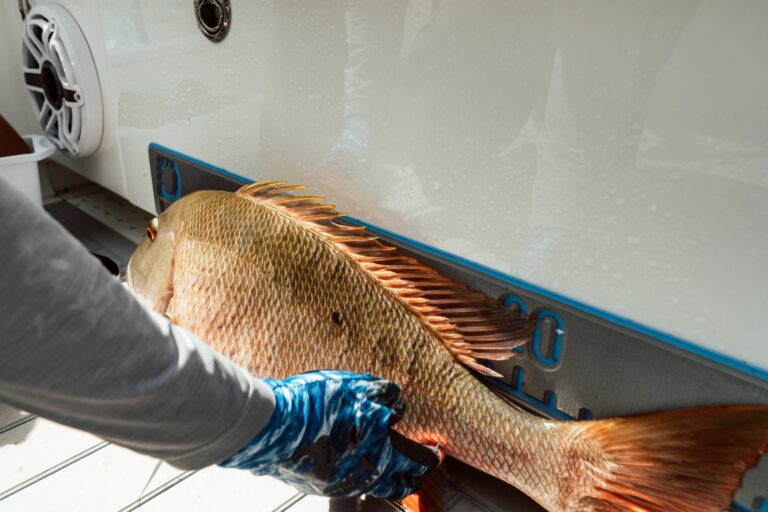How to Tie the Alberto Fishing Knot: Master the Technique for Successful Fishing
To tie the Alberto fishing knot, start by overlapping the main line and leader line, then make an overhand knot using both lines. (+4.621 characters) The Alberto fishing knot is a reliable and effective knot used by anglers to secure their main line and leader line together.
Whether you’re a beginner or a seasoned angler, mastering this knot is essential for ensuring a strong and secure connection between your lines. We will provide a step-by-step guide on how to tie the Alberto fishing knot. By following these simple instructions, you’ll be able to tie this knot with ease and have confidence in its strength when reeling in your catch.
So, let’s dive in and learn how to tie the Alberto fishing knot for your next fishing adventure.
Understanding The Alberto Fishing Knot: What You Need To Know
Understanding the Alberto Fishing Knot: What You Need to Know Importance of a strong and reliable fishing knot When it comes to fishing, one of the most crucial aspects is tying a strong and reliable knot. A poorly tied knot can cost you that trophy fish you’ve been dreaming of. That’s why it’s essential to understand the importance of using a strong and reliable fishing knot like the Alberto Fishing Knot. This knot not only ensures a secure connection between your line and your lure but also maintains its strength even under heavy tension. Say goodbye to lost fish and hello to a more successful and satisfying fishing experience! Introduction to the Alberto Fishing Knot The Alberto Fishing Knot has gained popularity among anglers for its simplicity and remarkable strength. Named after its creator, Alberto Knie, this knot is specifically designed for joining two lines of different diameters, making it perfect for connecting a fluorocarbon leader to a braided mainline. Its compact and low-profile design allows it to easily pass through rod guides, making it ideal for various fishing applications. Advantages of using the Alberto Fishing Knot There are several advantages of using the Alberto Fishing Knot over other types of knots. Firstly, this knot provides an incredibly strong and reliable connection that won’t slip or break when you least expect it. Whether you’re battling a trophy-sized fish or casting your line into the unknown depths, you can trust that the Alberto Fishing Knot won’t let you down. Moreover, this knot boasts outstanding knot strength, with tests showing that it retains over 90% of the line’s original strength. This means that even when you’re up against a powerful fish, you can fish with confidence knowing that your knot won’t compromise your chances of landing that prized catch. Materials and tools required for tying the Alberto Fishing Knot To tie the Alberto Fishing Knot, you’ll need a few materials and tools. Here’s a list of what you’ll need: 1. Fluorocarbon leader and braided mainline: These are the two lines you’ll be joining with the Alberto Fishing Knot. Ensure you have the appropriate diameters for both to make the knot secure and reliable. 2. Scissors or line cutter: You’ll need these to trim the excess line once the knot is tied. 3. A smooth and clean surface: A flat, clean surface will make it easier to tie the knot and ensure that the lines do not tangle. It’s important to have all these materials and tools ready before you start tying the Alberto Fishing Knot. Proper preparation will help you tie the knot seamlessly and save valuable fishing time. Now that you understand the importance of a strong fishing knot like the Alberto Fishing Knot, let’s move on to the next section where we’ll delve into the step-by-step process of tying this impressive knot.Step-by-step Instructions For Tying The Alberto Fishing Knot
Tying the Alberto fishing knot is essential for any angler looking to securely attach a line to a leader. This strong and reliable knot allows for smooth and efficient casting, giving you the confidence to reel in the big catches. To ensure you master this knot, follow these step-by-step instructions.
Preparation: Ensuring The Line And Leader Are Compatible
Before you begin tying the Alberto fishing knot, it is crucial to select line and leader materials that are compatible. This ensures optimal knot strength and prevents any weak points that could potentially lead to a lost fish. Ensure your line and leader are made from similar materials such as monofilament, fluorocarbon, or braided line, and double-check their pound test ratings to ensure compatibility.
Step 1: Creating The Initial Loop With The Leader
- Forming a small loop with the leader
To start the Alberto fishing knot, create a small loop with the leader by folding it over itself. This loop should be large enough to comfortably pass the line through but not too big that it compromises the knot’s overall strength.
- Ensuring the loop is properly positioned
Make sure that the loop is positioned towards the end of the leader and not too close to the tag end. This ensures that the tag end will be held securely when the knot is tightened.
Step 2: Wrapping The Line Around The Leader And Loop
- Wrapping the line around the leader and loop multiple times
With the loop in place, take the line and begin wrapping it around both the leader and the loop. Make approximately 10 to 12 wraps, ensuring that each wrap nestles tightly against the previous one. These wraps provide the knot’s strength and stability, so be sure to maintain consistent tension throughout the wrapping process.
- Maintaining tension throughout the wrapping process
As you wrap the line, ensure that you maintain constant tension on both the line and leader. This tension prevents any slippage or loosening of the wraps, guaranteeing a secure knot.
Step 3: Passing The Line Through The Loop
- Inserting the line through the loop created in Step 1
Once you have completed the wrapping process, take the tag end of the line and pass it through the loop created in Step 1. Guide the line through the loop, ensuring that it follows the same path as the wraps.
- Adjusting the tension of the knot
After passing the line through the loop, adjust the tension of the knot by pulling both the tag end and the standing line simultaneously. This step is crucial for ensuring that the wraps tighten securely around the leader, creating a strong and reliable connection.
Step 4: Tightening The Knot Securely
- Applying consistent and controlled pressure
To tighten the Alberto fishing knot, apply consistent and controlled pressure by pulling both the tag end and the standing line in opposite directions. This pressure will gradually tighten the wraps and lock the knot in place.
- Checking the tightness of the knot
Once you have tightened the knot, give it a quick inspection to ensure it is secure and tight. Take note of any loose wraps or areas that require additional tightening, and make any necessary adjustments. Ensuring the knot’s tightness guarantees that it will hold up even under intense pressure during battles with hard-fighting fish.
Tips And Tricks For Perfecting The Alberto Fishing Knot
When it comes to tying the Alberto Fishing Knot, there are a few tips and tricks that can help you achieve a perfect knot every time. Whether you’re a beginner or a seasoned angler, these techniques will ensure that your knots are strong, reliable, and able to withstand the toughest of fishing conditions.
Utilizing Lubrication For Smoother Knot Tying
One of the key factors in tying a perfect Alberto Fishing Knot is using lubrication to make the knot tying process smoother. Lubrication helps reduce friction between the line and the wraps, allowing the knot to cinch down tightly without causing any damage to the line or leader.
Before you start tying the knot, apply a small amount of lubricant to the line and leader. This can be done using a quality fishing line conditioner or even saliva if you’re in a pinch. The lubricant will help the line and leader slide smoothly through the wraps, ensuring a tight and secure knot.
Adjusting The Number Of Wraps Based On The Line And Leader Thickness
Another important aspect of perfecting the Alberto Fishing Knot is adjusting the number of wraps based on the thickness of your line and leader. The number of wraps required can vary depending on the strength and thickness of the materials you’re using.
As a general guideline, for lines and leaders with a smaller diameter, you may need to add more wraps to compensate for the reduced surface area of contact. Conversely, for lines and leaders with a larger diameter, fewer wraps may be sufficient. It’s important to experiment and find the optimal number of wraps for your specific setup, ensuring a secure and reliable knot.
Ensuring Proper Tension Throughout The Knot Tying Process
Proper tension is crucial when tying the Alberto Fishing Knot. Maintaining consistent tension throughout the knot tying process will ensure that the wraps are snug and secure, resulting in a strong and reliable knot.
As you proceed with tying the knot, make sure to pull both the line and leader ends with equal pressure to maintain tension. Avoid excessive force, as this can cause the wraps to overlap and weaken the knot. By keeping the tension consistent and balanced, you’ll achieve a knot that will hold up even in the toughest fishing conditions.
Testing The Strength And Reliability Of The Knot Before Fishing
Before heading out to fish, it’s essential to test the strength and reliability of the Alberto Fishing Knot. This step ensures that your knot will not fail when you have a fish on the line.
To test the knot, give it a firm tug to check for any slippage or unraveling. If the knot remains intact and doesn’t budge, you can have confidence in its strength. However, if you notice any signs of weakness, it’s important to re-tie the knot to ensure a secure connection.
By following these tips and tricks, you’ll be able to perfect your technique in tying the Alberto Fishing Knot. Remember to utilize lubrication for smoother knot tying, adjust the number of wraps based on the line and leader thickness, ensure proper tension throughout the knot tying process, and test the strength and reliability of the knot before fishing. With practice and attention to detail, you’ll be tying strong and reliable knots that will enhance your fishing experience.
Troubleshooting Common Issues With The Alberto Fishing Knot
The Alberto fishing knot is a popular choice among anglers due to its exceptional strength and reliability. However, like any knot, it can encounter certain issues that may affect its performance. In this section, we will explore some of the common problems that anglers face with the Alberto fishing knot and offer effective solutions for troubleshooting these issues.
Knot Slippage And How To Prevent It
Knot slippage can be a frustrating problem when using the Alberto fishing knot. The last thing you want is to lose a prized catch due to a slipped knot. One of the main causes of slippage is insufficient tightening of the knot. To prevent this, follow these steps:
- Ensure that you have wrapped the leader or mainline around the braid at least 7 to 10 times for a secure hold.
- After passing the tag end back through the loop, moisten the knot with water or saliva.
- Slowly pull both ends of the line simultaneously, taking care to apply even pressure. This will help in tightening the knot.
- Finally, once the knot is secure, trim any excess line close to the knot.
By following these steps, you’ll significantly reduce the chances of knot slippage and ensure a steadfast connection between your leader and mainline.
Dealing With Knot Failures And Breakages
Knot failures and breakages can occur for various reasons, such as friction against sharp objects or improper tying techniques. Here are some strategies to address these issues:
- Inspect the knot for any signs of wear, abrasion, or fraying. If you notice any damage, re-tie the knot to ensure a fresh and secure connection.
- Consider using a heavier pound test leader or mainline to reduce the chances of breakage under heavy loads.
- Apply a small amount of lubricant, such as line conditioner or saliva, to reduce friction and improve the knot’s strength.
By paying attention to potential weak points and taking proactive measures, you can avoid unexpected knot failures and maintain a strong connection during your fishing expeditions.
Strategies For Fixing A Poorly Tied Knot
Despite your best efforts, there may be instances when you notice a poorly tied Alberto fishing knot. It’s crucial to address this issue promptly to prevent any potential fishing mishaps. Here’s how to fix a poorly tied knot:
- Undo the existing knot and start over. This will give you a fresh start and allow you to tie the knot correctly.
- Pay close attention to each step of the tying process, ensuring that the wraps are neat and tight.
- Take your time and double-check the final knot before trimming any excess line.
By practicing patience and giving proper attention to detail, you can rectify a poorly tied Alberto fishing knot and achieve the secure connection you desire.
In conclusion, being aware of common issues with the Alberto fishing knot and knowing how to troubleshoot them will enhance your fishing experience. By following the guidelines provided for preventing knot slippage, dealing with knot failures, fixing a poorly tied knot, and identifying potential weak points, you can fish with confidence and ensure the knot’s reliability.
Conclusion
Mastering the Alberto fishing knot is a valuable skill that every angler should have in their arsenal. Its reliability and strength make it ideal for various fishing scenarios. By following the step-by-step guide provided in this blog post, you can quickly and easily tie the Alberto knot and enhance your fishing experience.
Practice and patience are key, but soon enough, you’ll be tying this knot with confidence and reaping the benefits on your next fishing trip. Happy fishing!





